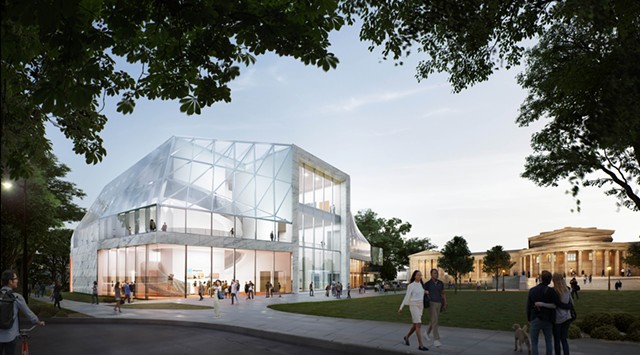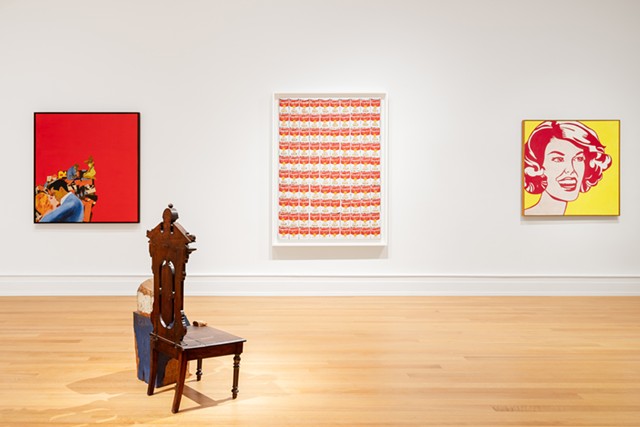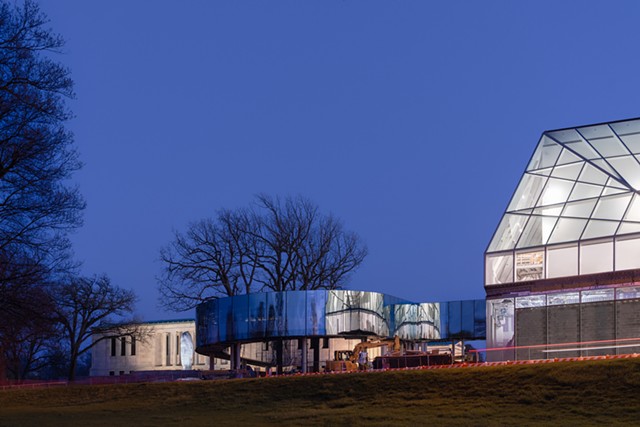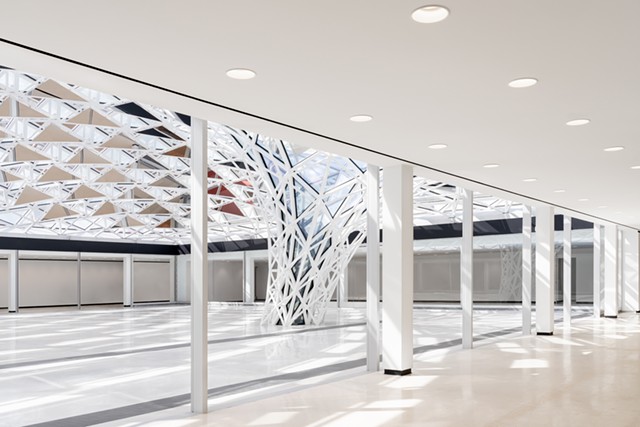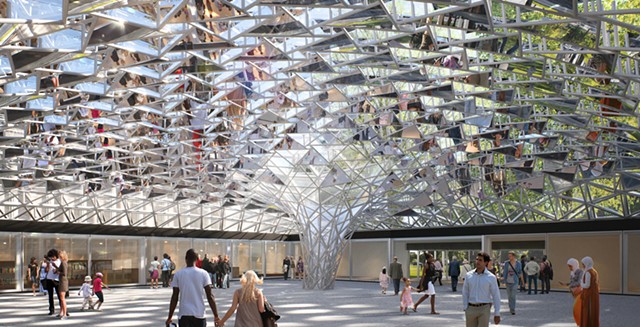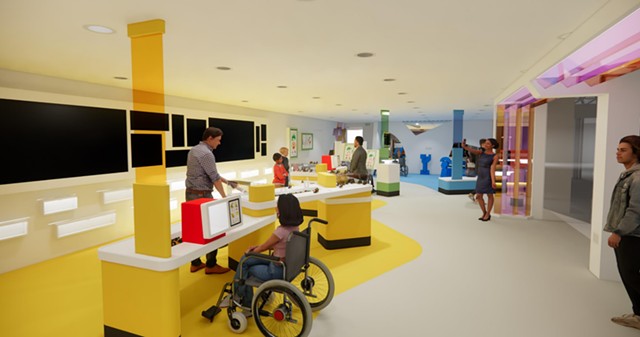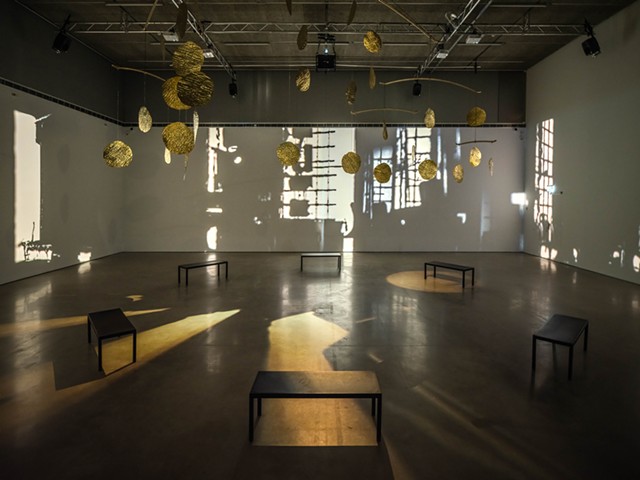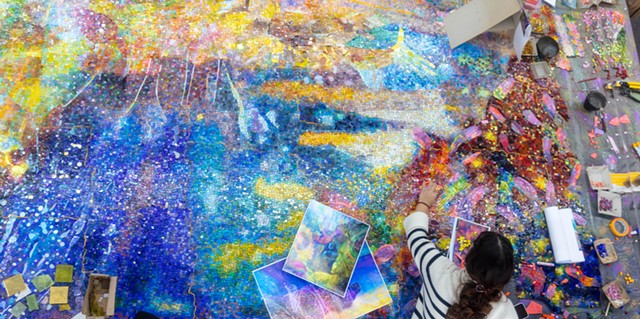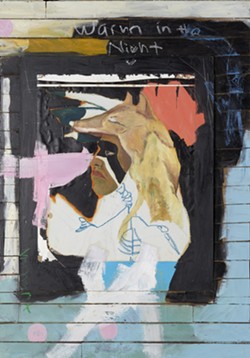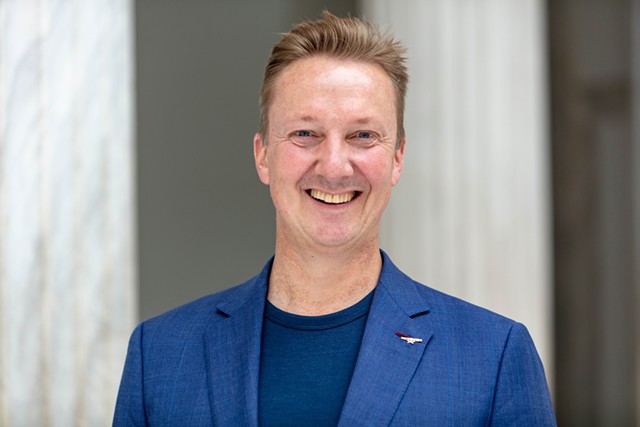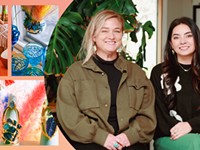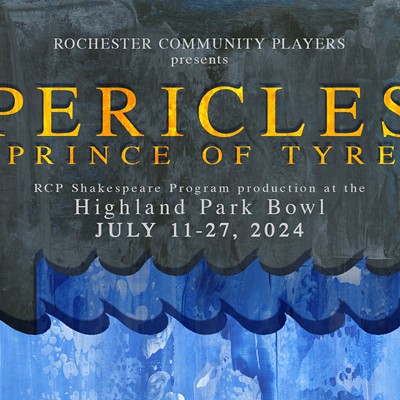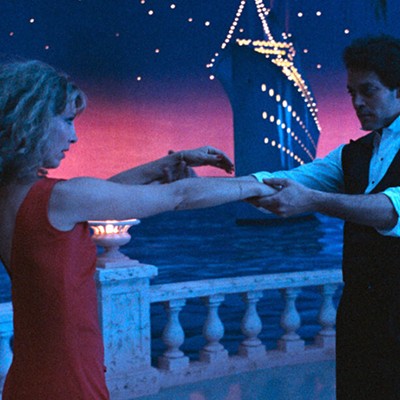[
{
"name": "500x250 Ad",
"insertPoint": "5",
"component": "15667920",
"parentWrapperClass": "",
"requiredCountToDisplay": "1"
}
]
Known until recently as the Albright-Knox Art Gallery, Buffalo’s most major art museum was founded during the Civil War in 1862. Today, it’s the 6th oldest public art institution in the United States and is on the cutting edge of contemporary museum culture.
Poised to reopen on June 12 after a four-year, $230 million expansion and renovation, the freshly dubbed Buffalo AKG Art Museum now houses more than 50,000 square feet of state-of-the-art exhibition space, five classroom studios, a public gathering space with a major sculptural commission, underground parking, and more than half an acre of public green space at its 1285 Elmwood Ave. campus.
And all that extra room means the ability to pull work out from the vaults into the gallery lights.
AKG Director Janne Sirén said in years past, the museum was able to show roughly 130 works from the collection at any given time.
“Now when our visitors come on opening day and thereafter, they will be able to see more than 400 works,” he said.
Everything about the museum’s new design, additions and recent acquisitions serves a central concern that preoccupies museums and major galleries as they shift fully into the 21st century: inclusion.
Entertaining largely white, well-off people who politely encounter high culture, museums have long needed to become open, interactive creative hubs and expand their collections of artistic voices to reflect a wider range of human experiences. The only alternative is to fade from relevance.
Now, at 161 years old, Buffalo AKG is poised to grow with generations far into the future.
INCREASING VISIBILITY AND ACCESS
A key word for the museum’s new identity is “porous.”
Major characteristics of the new building and renovations to the older ones promote visual communication between the museum’s interior and the outside world.
“Effectively, it's a way of pulling down that barrier that separates the museum from what lies beyond the museum,” Sirén said.
Designed by Shohei Shigematsu of the New York firm Office of Metropolitan Architecture (OMA) and New York firm Cooper Robertson, the new Jeffrey E. Gundlach Building is a glittering, glass-walled tower wrapped around a central, walled exhibition space that will keep the art safe from sunlight exposure. But visitors inside the halls and common spaces of the structure–as well as the serpentine glass skyway that connects the buildings–will be visible from street level, and they’ll be able to see the campus and bustling streets from inside the building. Some indoor sculptures will also be visible through the glass façade.
“Art museums have historically been somewhat, let's say, inaccessible—even just visually, castles on a hill,” Sirén said. “They've protruded this sense of inaccessibility, perhaps even elitism. So the challenge we gave to our architect and his team was a building that communicates with its public, with the surrounding environment, with the city, with the community.”
An entire wing of the museum will be free to visitors year-round. Museum leadership hopes the renovated Seymour H. Knox Building—and especially its new, central Town Square space—will be used by the public as a place to rest, eat lunch, and socialize.
Major structural changes to the Town Square’s ceiling, floors and walls were required to convert the 6,000-square-foot center from an outdoor courtyard and sculpture garden into a weather-tight room that would support the Knox building’s anchor artwork.
That work, “Common Sky,” is a several-ton, site-specific sculpture designed by renowned Icelandic-Danish installation artist Olafur Eliasson and Sebastian Behmann of Studio Other Spaces, and it’s in line with the AKG’s new transparent aesthetic. Heavy as it is, the work seems to float above the square—where performances, readings, and other events will be presented.
Overhead, dozens of mirrored and clear glass triangles serve as both reflections of the activity below and windows to the sky. Together, the panels funnel into a hollow column, also made of glass, reaching the floor. The sculpture doubles as a memorial to the apple tree that stood in the courtyard for decades. Its hollow, glass trunk (and drainage system under the floor), will bring the sky down “into” the space as it rains or snows.
“It allows us to be close to the elements even though the space is enclosed,” Sirén said.
The Town Square is flanked by a cafe called Cornelia—named for Cornelia Bentley Sage Quinton, the museum’s second director and the first woman director of a major art museum in the United States—and the Creative Commons, an accessible, multi-generational learning space that’s the result of the first ever philanthropic partnership between the LEGO Foundation and a fine art museum.
“That's a space where children of all ages, whether they are one or 90, can engage in various different types of activities and learn through the act of play,” Sirén said.
The Creative Commons will host hands-on creative learning opportunities and connections with museum collections. Each of the five new classroom studios has a specific programming focus, including a studio for children and their caregivers, and studios equipped with tools for making with different media.
The museum’s programming features inclusive engagement considerations, such as the multi sensory tours for people who are blind or have low vision, tours in partnership with Alzheimer’s Association of WNY, and an access program to support under-resourced groups and organizations working with people with disabilities.
REPRESENTATION IN THE COLLECTION AND PROGRAMMING
For any art lover, a stroll through the museum’s halls will yield an unending sequence of excited recognition. The walls are lined with important contemporary masterworks seemingly plucked from a survey of contemporary Western Art textbook, and more often than not they are the actual paintings, sculptures, and assemblages used in the textbooks as iconic representatives of an art genre or movement.
That includes Paul Gauguin’s “Yellow Christ,” and masterworks by Jackson Pollock, Mark Rothko, Andy Warhol, Clifford Still—too many cannon artists fill the collection to do it justice in a line or two.
The AKG has recently begun collecting more art from historically underrepresented demographics, with an emphasis on work made by living artists of color. Notably, the museum was early in acquiring art by African Americans—including sculptor Richard Hunt and painter Horace Pippin—while they were working artists in the 1940s and ’50s. But it was also guilty of the same institutional biases that have shaped museum collections for generations.
“What was on our walls was primarily by white men in the past,” Sirén said. “And as we look at the art world of today, it is not solely populated by white men—however revolutionary and radical they may have been, or might still be in some instances—they are women artists, artists representing different ethnic groups, different nationalities, different linguistic groups, different sexual orientations. All of these artists are in the mix of our work today.”
After the museum reopens, its inaugural exhibitions will include “Dreamers’ Quay,'' an immersive multi-channel video installation by Lap-See Sam, a Swedish artist of the Chinese diaspora, in the Gundlach Building’s Ronnen Glass Box Theater. It will also debut a site-specific artwork commissioned from Dominican artist Firelei Báez: a 30-foot-long mosaic based on an Afrofuturist myth about women cast overboard in the Middle Passage thriving underwater, titled “Chorus of the Deep (something ephemeral and beautifully whole, when seen from the edge of one’s vision, too full when taken head on).”
In recent years the museum has more aggressively collected works by Black, Latino, and Indigenous artists, including Niagara Falls-based artist Jay Carrier (Onondaga/Tuscarora).
Carrier’s painting “The Hand of the Devil Was Warm in the Night” came to the AKG’s collection in 2022. It’s a mixed media work of an Indigenous man with headdress regalia with a title drawn from U2’s song “I Still Haven’t Found What I’m Looking For”—a reflection of Carrier’s change of heart when he started the painting in 1985. He was then enrolled as a BFA student in Santa Fe, painting what he describes as “reductive” native imagery for the local tourists market.
“I didn't really feel good about selling them,” he said. “So I kind of changed my philosophy and perspective, how I wanted to represent myself as an artist, slash Native American artist.”
Carrier reworked the painting, which he said represents a pivot in both his style and meditations on identity. He said he’s proud that it’s part of a major contemporary collection today.
“Inroads are being made,” Carrier said, regarding museum representation of Indigenous fine artists. “But it comes in waves.”
A LIVING COLLECTION AND ITS COMMUNITY
The museum has more than doubled in size, but its growth can be measured in other ways. Under Sirén’s decade-long stewardship, its operating budget went from $6.7 million to $17 million. Full time museum staff increased from 62 to 150.
Sirén also launched the museum’s Public Art Initiative, its partnership with local government bodies and private businesses to support and install murals and sculptures throughout the city, spreading art to where more people live, work, and play.
After fundraising began for the expansion and renovation in 2016, the museum staff and architects conducted two years of town hall meetings to solicit input on what the community wanted to see.
Engaging audiences is a Sisyphean task, but one that the Buffalo AKG is up for, Sirén said.
When he became director in 2013, he was surprised to learn that more than 50-percent of the museum’s visitors were under 35—a remarkable statistic for a North American art museum, he said. For that he partially credits the museum’s longstanding efforts to expand representation in its collection and listen to what the public wants.
“I think that there's something sort of in the DNA of the museum—being on the cutting edge, being revolutionary for the sake of being revolutionary—I think it's been easier for us to pivot our collecting power,” Sirén said. “It hasn't been a challenge for us to be courageous once again, and expand the philosophical breadth and content of our collection to include and really foreground artists that previously may have been marginalized.”
Following the museum’s opening celebration and ribbon cutting on Monday, June 12, the Buffalo AKG will host an opening weekend Thursday, June 15 to Sunday, June 18, featuring free admission to the whole campus, performances and activities. Visit buffaloakg.org for details.
EXTRA, EXTRA:
The museum’s new half-acre Great Lawn and other surrounding green spaces will get some use this summer as visitors gather for free, open-air musical performances on the lawn and on the museum’s stone steps facing Olmstead’s Delaware Park and Hoyt Lake.
At 7 p.m. on Sunday, July 16, the Buffalo Philharmonic Orchestra will give a free concert on the Great Lawn.
The Lipsey Summer Jazz at Delaware Stairs series takes place on Sundays from July 23 through Aug. 13, and the chronological lineup is Silver Serenade: The Horace Silver Project (a quintet tribute to Silver’s lesser works); singer-saxophonist Camille Thurman with George Caldwell and Friends; singer Heather Bambrick with trumpeter Chase Sanborn; and The Buffalo Jazz Composers Workshop ensemble of composers and performers.
More details at buffaloakg.org.
Rebecca Rafferty is an arts writer for CITY. She can be reached at [email protected].
Poised to reopen on June 12 after a four-year, $230 million expansion and renovation, the freshly dubbed Buffalo AKG Art Museum now houses more than 50,000 square feet of state-of-the-art exhibition space, five classroom studios, a public gathering space with a major sculptural commission, underground parking, and more than half an acre of public green space at its 1285 Elmwood Ave. campus.
And all that extra room means the ability to pull work out from the vaults into the gallery lights.
AKG Director Janne Sirén said in years past, the museum was able to show roughly 130 works from the collection at any given time.
“Now when our visitors come on opening day and thereafter, they will be able to see more than 400 works,” he said.
Everything about the museum’s new design, additions and recent acquisitions serves a central concern that preoccupies museums and major galleries as they shift fully into the 21st century: inclusion.
Entertaining largely white, well-off people who politely encounter high culture, museums have long needed to become open, interactive creative hubs and expand their collections of artistic voices to reflect a wider range of human experiences. The only alternative is to fade from relevance.
Now, at 161 years old, Buffalo AKG is poised to grow with generations far into the future.
INCREASING VISIBILITY AND ACCESS
A key word for the museum’s new identity is “porous.”
Major characteristics of the new building and renovations to the older ones promote visual communication between the museum’s interior and the outside world.
“Effectively, it's a way of pulling down that barrier that separates the museum from what lies beyond the museum,” Sirén said.
Designed by Shohei Shigematsu of the New York firm Office of Metropolitan Architecture (OMA) and New York firm Cooper Robertson, the new Jeffrey E. Gundlach Building is a glittering, glass-walled tower wrapped around a central, walled exhibition space that will keep the art safe from sunlight exposure. But visitors inside the halls and common spaces of the structure–as well as the serpentine glass skyway that connects the buildings–will be visible from street level, and they’ll be able to see the campus and bustling streets from inside the building. Some indoor sculptures will also be visible through the glass façade.
“Art museums have historically been somewhat, let's say, inaccessible—even just visually, castles on a hill,” Sirén said. “They've protruded this sense of inaccessibility, perhaps even elitism. So the challenge we gave to our architect and his team was a building that communicates with its public, with the surrounding environment, with the city, with the community.”
An entire wing of the museum will be free to visitors year-round. Museum leadership hopes the renovated Seymour H. Knox Building—and especially its new, central Town Square space—will be used by the public as a place to rest, eat lunch, and socialize.
Major structural changes to the Town Square’s ceiling, floors and walls were required to convert the 6,000-square-foot center from an outdoor courtyard and sculpture garden into a weather-tight room that would support the Knox building’s anchor artwork.
That work, “Common Sky,” is a several-ton, site-specific sculpture designed by renowned Icelandic-Danish installation artist Olafur Eliasson and Sebastian Behmann of Studio Other Spaces, and it’s in line with the AKG’s new transparent aesthetic. Heavy as it is, the work seems to float above the square—where performances, readings, and other events will be presented.
Overhead, dozens of mirrored and clear glass triangles serve as both reflections of the activity below and windows to the sky. Together, the panels funnel into a hollow column, also made of glass, reaching the floor. The sculpture doubles as a memorial to the apple tree that stood in the courtyard for decades. Its hollow, glass trunk (and drainage system under the floor), will bring the sky down “into” the space as it rains or snows.
“It allows us to be close to the elements even though the space is enclosed,” Sirén said.
The Town Square is flanked by a cafe called Cornelia—named for Cornelia Bentley Sage Quinton, the museum’s second director and the first woman director of a major art museum in the United States—and the Creative Commons, an accessible, multi-generational learning space that’s the result of the first ever philanthropic partnership between the LEGO Foundation and a fine art museum.
“That's a space where children of all ages, whether they are one or 90, can engage in various different types of activities and learn through the act of play,” Sirén said.
The Creative Commons will host hands-on creative learning opportunities and connections with museum collections. Each of the five new classroom studios has a specific programming focus, including a studio for children and their caregivers, and studios equipped with tools for making with different media.
The museum’s programming features inclusive engagement considerations, such as the multi sensory tours for people who are blind or have low vision, tours in partnership with Alzheimer’s Association of WNY, and an access program to support under-resourced groups and organizations working with people with disabilities.
REPRESENTATION IN THE COLLECTION AND PROGRAMMING
For any art lover, a stroll through the museum’s halls will yield an unending sequence of excited recognition. The walls are lined with important contemporary masterworks seemingly plucked from a survey of contemporary Western Art textbook, and more often than not they are the actual paintings, sculptures, and assemblages used in the textbooks as iconic representatives of an art genre or movement.
That includes Paul Gauguin’s “Yellow Christ,” and masterworks by Jackson Pollock, Mark Rothko, Andy Warhol, Clifford Still—too many cannon artists fill the collection to do it justice in a line or two.
The AKG has recently begun collecting more art from historically underrepresented demographics, with an emphasis on work made by living artists of color. Notably, the museum was early in acquiring art by African Americans—including sculptor Richard Hunt and painter Horace Pippin—while they were working artists in the 1940s and ’50s. But it was also guilty of the same institutional biases that have shaped museum collections for generations.
“What was on our walls was primarily by white men in the past,” Sirén said. “And as we look at the art world of today, it is not solely populated by white men—however revolutionary and radical they may have been, or might still be in some instances—they are women artists, artists representing different ethnic groups, different nationalities, different linguistic groups, different sexual orientations. All of these artists are in the mix of our work today.”
After the museum reopens, its inaugural exhibitions will include “Dreamers’ Quay,'' an immersive multi-channel video installation by Lap-See Sam, a Swedish artist of the Chinese diaspora, in the Gundlach Building’s Ronnen Glass Box Theater. It will also debut a site-specific artwork commissioned from Dominican artist Firelei Báez: a 30-foot-long mosaic based on an Afrofuturist myth about women cast overboard in the Middle Passage thriving underwater, titled “Chorus of the Deep (something ephemeral and beautifully whole, when seen from the edge of one’s vision, too full when taken head on).”
In recent years the museum has more aggressively collected works by Black, Latino, and Indigenous artists, including Niagara Falls-based artist Jay Carrier (Onondaga/Tuscarora).
Carrier’s painting “The Hand of the Devil Was Warm in the Night” came to the AKG’s collection in 2022. It’s a mixed media work of an Indigenous man with headdress regalia with a title drawn from U2’s song “I Still Haven’t Found What I’m Looking For”—a reflection of Carrier’s change of heart when he started the painting in 1985. He was then enrolled as a BFA student in Santa Fe, painting what he describes as “reductive” native imagery for the local tourists market.
“I didn't really feel good about selling them,” he said. “So I kind of changed my philosophy and perspective, how I wanted to represent myself as an artist, slash Native American artist.”
Carrier reworked the painting, which he said represents a pivot in both his style and meditations on identity. He said he’s proud that it’s part of a major contemporary collection today.
“Inroads are being made,” Carrier said, regarding museum representation of Indigenous fine artists. “But it comes in waves.”
A LIVING COLLECTION AND ITS COMMUNITY
The museum has more than doubled in size, but its growth can be measured in other ways. Under Sirén’s decade-long stewardship, its operating budget went from $6.7 million to $17 million. Full time museum staff increased from 62 to 150.
Sirén also launched the museum’s Public Art Initiative, its partnership with local government bodies and private businesses to support and install murals and sculptures throughout the city, spreading art to where more people live, work, and play.
After fundraising began for the expansion and renovation in 2016, the museum staff and architects conducted two years of town hall meetings to solicit input on what the community wanted to see.
Engaging audiences is a Sisyphean task, but one that the Buffalo AKG is up for, Sirén said.
When he became director in 2013, he was surprised to learn that more than 50-percent of the museum’s visitors were under 35—a remarkable statistic for a North American art museum, he said. For that he partially credits the museum’s longstanding efforts to expand representation in its collection and listen to what the public wants.
“I think that there's something sort of in the DNA of the museum—being on the cutting edge, being revolutionary for the sake of being revolutionary—I think it's been easier for us to pivot our collecting power,” Sirén said. “It hasn't been a challenge for us to be courageous once again, and expand the philosophical breadth and content of our collection to include and really foreground artists that previously may have been marginalized.”
Following the museum’s opening celebration and ribbon cutting on Monday, June 12, the Buffalo AKG will host an opening weekend Thursday, June 15 to Sunday, June 18, featuring free admission to the whole campus, performances and activities. Visit buffaloakg.org for details.
EXTRA, EXTRA:
The museum’s new half-acre Great Lawn and other surrounding green spaces will get some use this summer as visitors gather for free, open-air musical performances on the lawn and on the museum’s stone steps facing Olmstead’s Delaware Park and Hoyt Lake.
At 7 p.m. on Sunday, July 16, the Buffalo Philharmonic Orchestra will give a free concert on the Great Lawn.
The Lipsey Summer Jazz at Delaware Stairs series takes place on Sundays from July 23 through Aug. 13, and the chronological lineup is Silver Serenade: The Horace Silver Project (a quintet tribute to Silver’s lesser works); singer-saxophonist Camille Thurman with George Caldwell and Friends; singer Heather Bambrick with trumpeter Chase Sanborn; and The Buffalo Jazz Composers Workshop ensemble of composers and performers.
More details at buffaloakg.org.
Rebecca Rafferty is an arts writer for CITY. She can be reached at [email protected].
Speaking of...
-
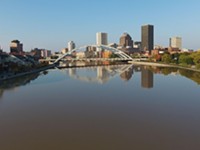
Cultural institutions join forces to draw summer tourists
May 28, 2021 -
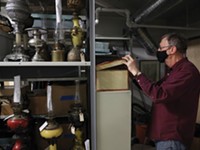
History in the unmaking
Mar 1, 2021 -
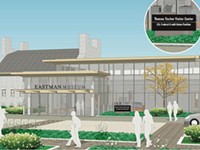
Eastman Museum reveals ambitious renovation plans
Jan 8, 2020 - More »
Latest in Art
More by Rebecca Rafferty
-

Beyond folklore
Apr 4, 2024 -

Partnership perks: Public Provisions @ Flour City Bread
Feb 24, 2024 -

Raison d’Art
Feb 19, 2024 - More »
